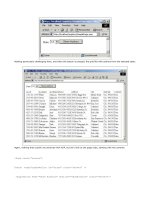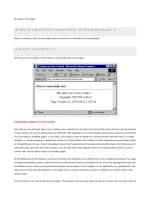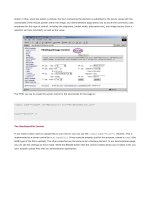Professional ASP.NET 1.0 Special Edition- P4 pdf
Bạn đang xem bản rút gọn của tài liệu. Xem và tải ngay bản đầy đủ của tài liệu tại đây (283.18 KB, 40 trang )
In C# there is no direct distinction between a Sub and a Function, and members are just implemented as functions (that
may, or may not, return data). The syntax is:
[ public | protected | internal | protected internal | private | static |
virtual | override | abstract | extern ]
[ type | void ] memberName([parameters])
{
}
The various keywords are described below:
Keyword
Description
public
The member is publicly accessible.
protected The member is only accessible from the containing class or types derived from the containing member.
internal
The member is only accessible from this program. Equivalent to Friend in Visual Basic.
Table continued on following page
Keyword
Description
protected
The member is only accessible from this program, or types derived from the containing member.
internal
Equivalent to Protected Friend in Visual Basic.
private
The member is only accessible from within the containing member.
The member is shared by all instances of the class, and exists independently of a class instance.
static
virtual
Equivalent to Shared in Visual Basic.
The member can be overridden by a sub-class.
The member overrides an identically named member from a base class, with the same signature. The
override
base class member must be defined as virtual, abstract or override.
abstract
This member is an abstract member, and must be implemented by a sub-class.
extern
The member is implemented in an external assembly.
For example:
public class calculator
{
public double Add(double op1, double op2)
{
return op1 + op2;
}
}
For a method that does not return a result, we declare the type as void:
public void updateSomething()
{
}
Properties
Properties in C# are very similar to Visual Basic .NET, and can be implemented as public member variables or by using
the property accessors. For example, the following uses public variables:
public class calculator
{
public double Op1;
public double Op2;
public double Add()
{
return Op1 + Op2;
}
}
The alternative (and preferred) approach is to use property accessors. For example:
public class calculator
{
private double _op1;
private double _op2;
public double Operand1
{
get
{
return _op1;
}
set
{
_op1 = value;
}
}
public double Operand2
{
get
{
return _op2;
}
set
{
_op2 = value;
}
}
}
Unlike Visual Basic, there are no specific keywords to identify read- and write-only properties. If only the get accessor is
provided then the property is read-only, and if only the set accessor is provided then the property is write-only. Both
accessors imply a read/write property.
Constructors
Rather than using New for constructors, the C# syntax is to use a method with the same name as the class. For example:
public class person
{
private string _firstName;
private string _lastName;
public person() {}
public person(string firstName, string lastName)
{
_firstName = firstName;
_lastName = lastName;
}
public string FirstName
{
// property accessors here
}
public string LastName
{
// property accessors here
}
}
Destructors
For destructors there is no Destruct keyword. This functionality is provided by a method with the same name as the
class, but with a tilde (~) in front of it. For example:
public class person
{
private string _firstName;
private string _lastName;
public person() {}
public person(string firstName, string lastName) { }
~person()
{
// destructor code here
}
}
Like Visual Basic .NET, destructors in C# are called by the garbage collector, and are not guaranteed to be executed at the
time you destroy the class.
Inheritance
Inheritance in C# looks more like C++, where a colon (:) is used to separate the class and the base class. For example:
public class programmer : person
{
private int _avgHoursSleepPerNight;
public programmer(): base()
{
}
public programmer(string firstName, string lastName):
base(firstName, lastName)
{
}
public programmer(string firstName, string lastName, int hoursSleep):
base(firstName, lastName)
{
_avgHoursSleepPerNight = hoursSleep;
}
public int AvgHoursSleepPerNight
{
get { return _avgHoursSleepPerNight; }
set { _avgHoursSleepPerNight = value; }
}
}
The class definition defines that our class is called programmer and the base class is called person:
public class programmer : person
{
Next we need to provide the constructors. Here we specify the same constructors as the base class, and use the same
inheritance syntax (the :) to indicate that this method inherits its implementation from the base class. Any parameters
should be passed to the base class constructor.
public programmer(): base()
{
}
public programmer(string firstName, string lastName):
base(firstName, lastName)
{
}
To declare an additional constructor we follow the same rules, invoking the base constructor, but also providing additional
functionality:
public programmer(string firstName, string lastName, int hoursSleep):
base(firstName, lastName)
{
_avgHoursSleepPerNight = hoursSleep;
}
And finally we have the new property:
public int AvgHoursSleepPerNight
{
get { return _avgHoursSleepPerNight; }
set { _avgHoursSleepPerNight = value; }
}
}
The value keyword is implemented automatically by the CLR, providing the property with the supplied value from the
calling program.
Interfaces
Interfaces work the same as in Visual Basic .NET, providing an immutable contract to the external world.
To create an interface, we use the interface construct. For example:
public interface IPerson
{
string FirstName(get; set;)
string LastName(get; set;)
string FullName();
}
To derive a class from an interface, we use the same method as inheritance:
public class Person : IPerson
{
private string _firstName;
private string _lastName;
public string FirstName()
{
// implementation goes here
}
public string LastName()
{
// implementation goes here
}
public string FullName()
{
return _firstName + " " + _lastName;
}
}
Notice that unlike Visual Basic .NET, only the class needs to specify the interface inheritance.
References
References use the same method as Visual Basic .NET, but with the keyword using instead of Imports. For example:
using System;
using MyComponent;
It's also possible to alias references using the following syntax:
using aliasName = Namespace;
If an alias is used, the alias must be included in references to classes that the namespace contains. For example, if we
have a namespace called MyComponent containing a class called MyClass, and import the namespace like this:
using foo = MyComponent;
we can't then access the class like this:
MyClass comp = MyClass
We have to use this syntax:
foo.MyClass comp = foo.MyClass
Exception Handling
The try … catch … finally combo is also the way exception handling is performed in C#, using the following syntax:
try
{
// code block to try
}
[catch[(type exception)]
{
// code block to run if the exception matches the type above
}]
catch[(type exception)]
{
// code block to run if the exception matches the type above
}
finally
{
' code that always runs, whether or not
' an exception was caught
}
For example:
try
{
// connect to a database and
// retrieve some data
// ... code left out for clarity ...
}
catch(SQLException exSQL)
{
ErrorLabel.Text = "SQL Error: " + exSQL.ToString();
}
catch(Exception ex)
{
ErrorLabel.Text = "Other error: " + ex.ToString();
}
finally
{
FinishedLabel.Text = "Finished";
}
The throw statement can be used to raise errors, even when in try - catch blocks. For example:
try
{
// some code here
}
catch(SQLException exSQL)
{
if (some expression)
throw(exSQL);
}
XML Documentation
One really great feature that C# has over Visual Basic is the ability to include inline documentation. This is done by placing
a set of XML tags at various places in our code, and then adding a compiler directive to pull out the comments. For
example:
using System;
namespace peopleCS
{
///<remarks>
///The <c>programmer</c>class defines the salient
///attributes of every fine programmer.
///<seealso cref="person">Inherits from person</seealso>
///</remarks>
public class programmer : person
{
private int _avgHoursSleepPerNight;
///<summary>Default constructor</summary>
public programmer(): base()
{ }
///<summary>Constructor using first and last names</summary>
///The first name of the programmer</param>
///The last name of the programmer</param>
///<seealso cref="string"/>
public programmer(string firstName, string lastName):
base(firstName, lastName)
{ }
///<summary>Constructor using first and last names and
///the hours of sleep</summary>
///The first name of the programmer</param>
///The last name of the programmer</param>
///The average number of hours of sleep</param>
///<seealso cref="string"/>
///<seealso cref="int"/>
public programmer(string firstName, string lastName, int hoursSleep):
base(firstName, lastName)
{
_avgHoursSleepPerNight = hoursSleep;
}
///<value>Defines the average number of hours of sleep.</value>
public int AvgHoursSleepPerNight
{
get { return _avgHoursSleepPerNight; }
set { _avgHoursSleepPerNight = value; }
}
}
}
Notice how the XML tags are placed after three /// characters - not to be confused with two, as used by comments. The
tags we can use are as follows:
Tag
Description
c
Text that indicates inline code.
code
Multiple lines of code, such as a sample.
example
Description of a code sample.
Indicates an exception class. Additionally, the attribute cref can be used to reference another type (such as
exception
include
the exception type). This reference is checked against the imported libraries.
Allows XML documentation to be retrieved from another file.
Indicates a list of items. The type attribute can be one of:bullet, for bulleted listsnumber, for numbered
liststable, for a tableYou can use a listheader element to define headings, and an item element to
list
define the items in the list. Each of these can contain two elements: item for the item being listed, and
description.
para
Allows paragraph definitions within other tags.
param
Describes the parameter of a method. The name attribute should match the name of the parameter.
Table continued on following page
Tag
Description
paramref
Used to indicate references for parameters.
Describes the permissions required to access the member. The cref can be used to reference another type
permission
(such as the security permission type). This reference is checked against the imported libraries.
remarks
Overview information about the class or type.
returns
The return value of a method.
The attribute cref is used to reference another type (such as a related member). This reference is checked
see
against the imported libraries.
The attribute cref is used to reference another type (such as a related member), to be documented in the
seealso
See Also section. This reference is checked against the imported libraries.
summary
Description of a member or type.
value
Description of a property.
In Visual Studio, these tags can be processed to form HTML pages that become part of the project documentation. Outside
Visual Studio, we can produce an XML file for the comments by using the /doc compiler switch (more on these later),
which produces the file like so:
<?xml version="1.0"?>
<doc>
<assembly>
<name>PeopleCS</name>
</assembly>
<members>
<member name="T:peopleCS.programmer">
<remarks>
The <c>programmer</c>class defines the salient
attributes of every fine programmer.
<seealso cref="T:peopleCS.person">Inherits from person</seealso>
</remarks>
</member>
<member name="M:peopleCS.programmer.#ctor">
<summary>Default constructor</summary>
</member>
<member name="M:peopleCS.programmer.#ctor(System.String,System.String)">
<summary>Constructor using first and last names</summary>
The first name of the programmer</param>
The last name of the programmer</param>
<seealso cref="T:System.String"/>
</member>
<member name="M:peopleCS.programmer.#ctor(System.String, System.String,System.Int32)">
<summary>Constructor using first and last
names and the hours of sleep</summary>
The first name of the programmer</param>
The last name of the programmer</param>
The average number of hours of sleep</param>
<seealso cref="T:System.String"/>
<seealso cref="T:System.Int32"/>
</member>
<member name="P:peopleCS.programmer.AvgHoursSleepPerNight">
<value>Defines the average number of hours of sleep.</value>
</member>
</members>
</doc>
The compiler automatically includes the namespace and builds tags for the member names. The members are given a fully
qualified name starting with one of the following prefixes:
Prefix Description
N
Namespace
T
Type: Class, Interface, Struct, Enum, or Delegate
F
Field
P
Property (including indexers)
M
Method (including constructors)
E
Event
!
Error string if links cannot be resolved
You could then use an XSLT stylesheet, or XML processing code to style this into your own documentation. You could also
add your own XML elements to the class descriptions, and these would be extracted along with the predefined elements.
Unsafe Code
Although C# is part of the managed code environment, Microsoft has realized that sometimes developers need total
control, such as when performance is an issue, when dealing with binary structures, or for some advanced COM support.
Under these circumstances, we are able to use C# code in an unsafe manner, where we can use pointers, unsafe casts,
and so on.
As an ASP.NET developer it's unlikely you'll ever need this, but knowing it's available gives us the flexibility to choose,
should the need arise. Consult the C# documentation or Wrox's Professional C# Programming, ISBN 1-86007-04-3
for more information on this.
Operator Overloading
C# is the only one of the supplied languages that supports operator overloading. This works in the same way as method
overloading, but for operators. The reason for this is to allow the standard operators to be used on objects such as classes.
The classic example given is a class for handling complex numbers, which have a real and imaginary part (stored as
integers). Imagine a class that has two properties for these two parts, and a constructor that takes two arguments to
match the properties:
CNumber c1 = new CNumber(12, 4);
CNumber c2 = new CNumber(5, 6);
When performing addition on complex numbers, we must add the real part and imaginary part independently of each
other, and might consider creating this method:
public CNumber Add(CNumber c1, CNumber c2)
{
return new CNumber(c1.real + c2.real, c1.imag + c2.imag);
}
We could then call this by:
CNumber c3 = CNumber.Add(c1, c2);
There's nothing wrong with that per se, but it would be far better to use:
CNumber c3 = c1 + c2;
To achieve this, we would have to overload the + operator:
public static CNumber operator +(CNumber c1, CNumber c2);
{
return new CNumber(c1.real + c2.real, c1.imag + c2.imag);
}
This provides a much more intuitive way of developing, and is especially useful when building class libraries for other
developers.
JScript .NET
Like Visual Basic, JScript has also undergone some changes, although not as radical. The first thing to realize is that
JScript .NET is a full .NET language, and therefore provides the advantages that the other supported languages do. In fact,
JScript .NET has been completely rewritten in C#. It now supports types and inheritance, and is fully compiled.
Although completely rewritten, JScript .NET is more evolutionary, and still supports existing JScript functionality - the new
features are extra, and (apart from compilation, which is a CLR requirement) not enforced.
Like C#, JScript .NET is case sensitive.
Data Types
The first new feature is that we can now use JScript .NET as a fully typed language. This isn't enforced, so there are two
varieties of variable type usage:
Type inferencing
Data types
Type Inferencing
If we choose to keep the existing form of JScript, without types, then the data type of a variable is inferred from its context.
For example, consider the following:
var idx;
for (idx = 0 ; idx < 10 ; idx++)
{
}
The compiler infers the type for idx from its usage. This doesn't really change from the way the script engine runs with
previous versions of JScript, except that now it's the compiler that does the work.
Data Types
If we want to use data types, then we use a colon (:) to specify the type. The new syntax is:
var name : type[[]] [ = value ]
For example:
var firstName : String // JScript String
var dateOfBirth : Date // JScript Date
var lastName : System.String // .NET Framework string
var names : String[] // array of JScript Strings
Notice that both JScript and .NET types are supported.
Namespaces
Namespaces are provided using the package keyword, which is equivalent to the Visual Basic and C# namespace
keyword. For example:
package People
{
// classes go here
}
Classes
Because JScript .NET is implicitly supported by the CLR, the class support is just like that of the other languages. The high
level syntax is:
[ attributes ] class className [extends baseClassName] [implements interfaceName]
{
}
The attributes can be one or more of:
Attribute Description
expando
The class supports dynamic properties, and is given a default indexed property.
public
The class is publicly accessible.
The class is only visible within the package in which it is declared. Equivalent to Friend in Visual Basic and
internal
internal in C#.
This class is an abstract class, and the class members must be implemented by inheriting classes. Equivalent
abstract
final
to MustInherit in Visual Basic.
This class cannot be inherited. Equivalent to NotInheritable in Visual Basic and sealed in C#.
For example:
public class Calculator
{
// implementation goes here
}
Methods
Like C#, JScript .NET uses functions for methods, using the following syntax:
[attributes] function memberName([parameters]) [: type]
{
}
The attributes can be one or more of the following:
Attribute Description
override The member overrides an identically named member from a base class.
hide
The member does not override an identically named member from a base class.
Modifier
Description
public
The class is publicly accessible.
The member is only visible within the package in which it is declared. Equivalent to Friend in Visual Basic
internal
and internal in C#.
protected The member is only accessible from the containing class or types derived from the containing member.
private
The member is only accessible from within the containing member.
The member is shared by all instances of the class, and exists independently of a class instance. Equivalent
static
to Shared in Visual Basic.
This member is an abstract member, and must be implemented by inheriting classes. Equivalent to
abstract
final
MustInherit in Visual Basic.
This method cannot be overridden, although it can be hidden or overloaded.
For example:
public class calculator
{
public function Add(op1 : double, op2 : double) : double
{
return op1 + op2;
}









